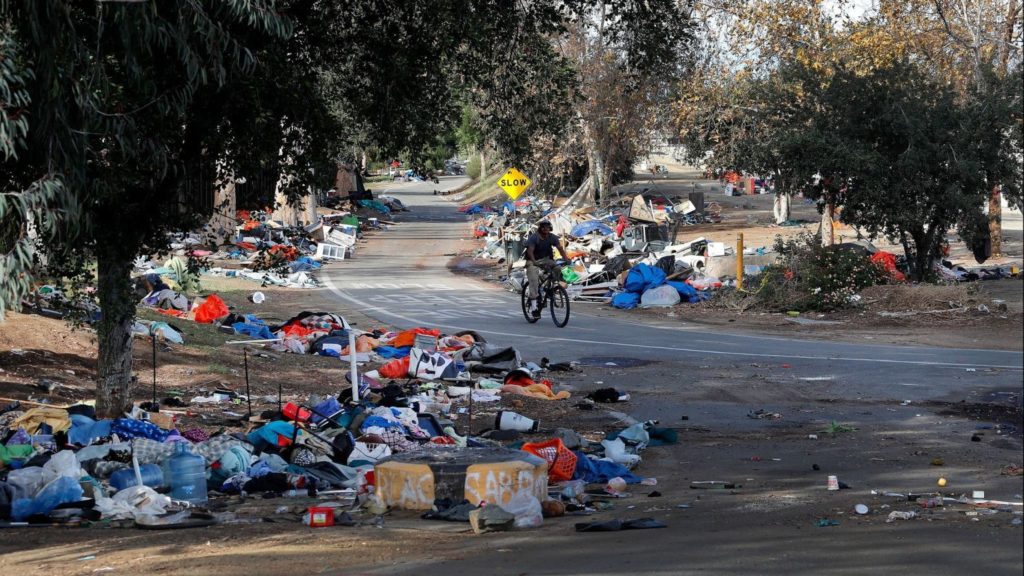
Increasing levels of homelessness have been observed all over the Western World. The waiting list of families in severe need of housing in New Zealand has increased sevenfold since 2016, and has nearly quadrupled since the Sixth Labour Government came to power in late 2017. A similar situation exists in America, where “tent cities” of homeless people now surround major metropolitan areas.
A great deal of thought has gone into solving this crisis – or so we’re told. Apparently it’s an issue of great concern to the leaders of the West, who are doing everything they can to get their young people into houses. The reality is that they don’t care about homelessness at all – in fact, they want more of it. Homelessness serves a very important social role.
Like much of human behaviour, whether or not the lower classes rebel is a function of two factors: reward and risk.
The greater the reward for rebelling, the greater the likelihood it will happen. The more oppressed a people are, the greater the reward for rebelling. Anyone who has to endure daily humiliations, especially those of a physical kind, will soon come to feel that it’s worth rolling the dice.
The greater the risk for rebelling, the less the likelihood it will happen. This is why ancient kings used to put every male in rebellious villages to the sword. Others had to learn that the consequences of rebellion were either self-determination or death.
The ruling classes have always had to keep this reward-to-risk balance titled towards not rebelling. A failure to do so could mean that those ruling classes were violently deposed.
Ever since the advent of agriculture, the ruling classes have been preoccupied with one question: how to get people to work. Tilling fields is much less interesting than hunting. Left to their own devices, people would rather hunt and fish, and then lie around the rest of the time, than till fields and accumulate a surplus of grain.
Using violence to force people to work led to rebellion. So the ruling classes had to be subtle about tinkering with the reward-to-risk ratio.
One approach was to increase the reward for working. This was originally how early societies came to have a schedule of festivals, such as harvest festivals in Autumn, fertility festivals in Spring, and festivals for Midsummer and Midwinter. The idea was that people would more readily work a week of tilling fields if they had a festival to look forward to.
The other approach was to increase the risk of not working. As mentioned above, the ruling class couldn’t simply whip people, because they would rebel. The punishment for not working had to be more subtle. The usual solution was ostracisation. Anyone considered to not be working hard enough was deemed a ‘bludger’ or ‘malingerer’ and abused psychologically, instead of physically.
In contrast to physical abuse, psychological abuse can be dished out with very little chance of retaliation. So the ruling classes of today seek to maximise the amount of psychological abuse they inflict upon the lower classes, and that means spreading fear. The ruling class, in the final analysis, are little different to terrorists, and to that end they deliberately cultivate visible homelessness.
Most homelessness has been purposefully created by the ruling class, because they need to have people visibly suffering in public in order to scare the rest of the population into submission. In the terms used above, homelessness has been purposefully cultivated by the ruling class in order to increase the risk of not working.
The presence of homelessness means that the working classes put their heads down and obey orders without complaint, for fear of being made homeless themselves.
Many people have wondered about the logic of doubling the refugee quota, as Labour did in 2017. It seemed especially mysterious, as we were already in the grip of a housing crisis at the time, and each refugee family we housed meant one Kiwi family had to go without.
But that was the precise outcome intended.
The reason why they let the refugees in, and give them housing, while leaving Kiwis to suffer homeless, is because they want Kiwis to suffer. They want the average New Zealander to see his fellows suffering and homeless every day, because this will keep the average New Zealander compliant.
This strategy, which could be summarised as “A boot stamping on a human face, forever,” has reached its apogee in today’s America, where major Californian cities are now surrounded by miles and miles of tents. Los Angeles is believed to contain 60,000 homeless, many of who live in tents in the downtown commercial area.
This need to threaten people into submission is why they will never solve the homelessness crisis.
Much like cannabis prohibition, homelessness serves the purpose of signalling the government’s cruelty, and thereby works to bring the lower classes into a state of compliance. The homeless have to be there, so that the average citizen can be reminded of the consequences of resisting the government’s will. The more tyrannical the government becomes, the more homeless there will be.
The presence of homeless people, then, could be considered a sign of tyranny. Therefore, the homelessness problem won’t be solved until the tyranny one is.
*
If you enjoyed reading this essay/article, you can get a compilation of the Best VJMP Essays and Articles of 2019 from Amazon for Kindle or Amazon for CreateSpace (for international readers), or TradeMe (for Kiwis). A compilation of the Best VJMP Essays and Articles of 2018 and the Best VJMP Essays and Articles of 2017 are also available.
*
If you would like to support our work in other ways, please consider subscribing to our SubscribeStar fund. Even better, buy any one of our books!
